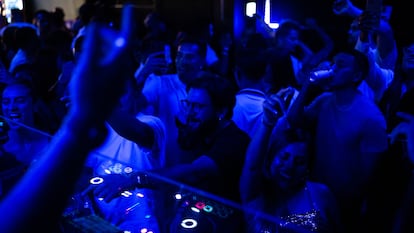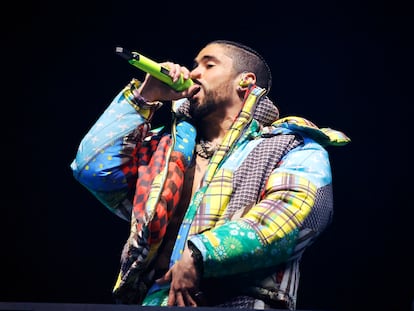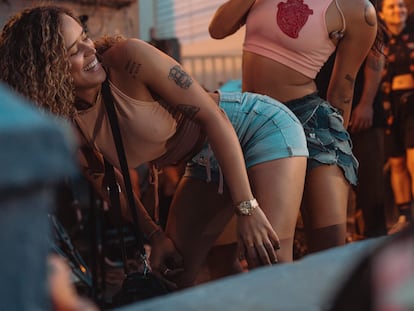Welcome to Perro Negro, the temple of ‘perreo’
This Medellín nightclub has become so popular that Bad Bunny, one of the most important reggaeton artists, recently released a song with its name as the title
There are bodies everywhere, pressed against each other. It is packed. A thousand things seem to be going on on the dark dance floor. A group of friends drink straight from a bottle as they sing reggaeton classics at the top of their lungs. A couple in their twenties dances sensually, kissing, smiling. You can tell they are in love. A tall, handsome, muscular boy dances with one girl after another. He is the star of the night. At some corner, a girl has been dancing barefoot for at least two hours. The lack of shoes does not slow her down; she is grinding like there’s no tomorrow.
Suddenly the song changes, the lights turn on and hundreds of people take out their cell phones to record: it is the moment they have been waiting for. The club becomes a choir that belts out, in unison with Bad Bunny: “Vi que te dejaste de tu novio, baby me alegro. Vamos a celebrarlo en Perro Negro” (I saw that you left your boyfriend, baby, I’m glad. Let’s go celebrate at Perro Negro). They shout. Everything explodes. Bodies rub against bodies. People jump and hug with friends. More alcohol passes from bottles to mouths. It’s absolute chaos.
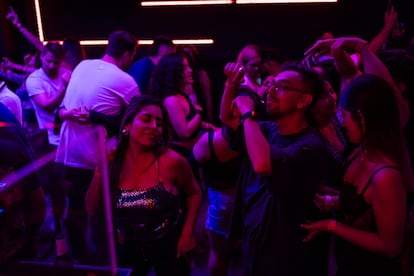
Welcome to Perro Negro (which literally translates to black dog), “the temple of perreo,” according to Alejandro Cardona, owner and founder. In recent years, this small Medellín nightclub — the dance floor is a little over 1,000 square feet — has become a sacred place for lovers of reggaeton. So much so, that one of the most important artists of the genre, the Puerto Rican Bad Bunny, released a song a month ago (featuring Feid) that bears the name of the place. Cardona says that he cried with happiness the first time he heard it. “We were already full every night, but that song raised us to another level,” he adds, and smiles.
At first glance, there is nothing special about Perro Negro. Tucked away in the basement of a commercial building in Provenza — one of the most touristy neighborhoods in the capital of the department of Antioquia — it is a humid, austere space whose capacity does not exceed 250 people. There is a “tiny” dance floor, explains Cardona, two bars, a few tables, a DJ booth, a “very cool” lighting system, and that’s it. Its minimalist design makes it look more like a Berlin nightclub than a Latin American club where the most famous reggaeton artists in the world go.
That is exactly how Cardona conceived it. “I am passionate about electronic music, but reggaeton was always there, being from Medellín,” he explains. For him, the combination of an electronic party atmosphere and the respect for reggaeton — a genre that has taken over the city in recent years — is what gives Perro Negro its spark. “The energy density is insane,” he says.
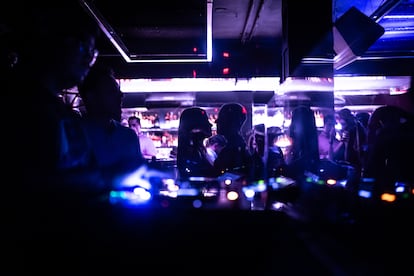
That energy is what brings Laura Rodríguez to this club. The 24-year-old Medellín native is wearing a tight, sparkly, silver dress as she stands in line outside the door with at least 40 other people. With a cigarette in one hand and a beer in the other, she explains that it is her fourth time there, and the first with her current boyfriend. “I like that they only play reggaeton. I feel free. It’s like dancing in your neighborhood, but without the bad parts of a neighborhood party,” she says.
Karen Salazar Uribe is a 28-year-old DJ from a working-class neighborhood. She explains that Perro Negro is cooler because it understands the history of reggaeton and what this type of music means to many people. Salazar Uribe, the co-founder of Motivando a la Gyal — a group that advocates for the creation of safe spaces where women can enjoy urban music — says that reggaeton “naturally flows through” the residents of Medellín. “It’s part of our lives and our environments, like conflict or violence,” she states, and explains that this rhythm was an essential part of her own development: “I can’t imagine growing up in my neighborhood without reggaeton. I wouldn’t have crossed the invisible borders that I crossed without it. I wouldn’t know the city like I know it.”
From Medellín to Miami
The story of Perro Negro, like almost all stories in the capital of Antioquia, begins in a neighborhood. Cardona, the creative director of The Hacienda — the company behind this club and other restaurants and bars in the city — is tall and tattooed. He wears a “seven,” one of the most popular haircuts in Medellín. He is 31 years old and says he has been working in parties and entertainment all his life.
It all started in 2009 in Villa de Aburrá, the upper-middle class neighborhood west of the city where he grew up. The Library-Park had opened an outdoor space where the public could hold events, and Cardona, who was 17 at the time, took advantage of it. “I wrote them and told them that I was a minor and that I wanted to organize an electronic music party,” he says. They agreed and, after a couple of social media posts, the boy arrived with two borrowed speakers and a DJ. “It was my first time. I loved it,” he recalls. That Sunday there were only 15 people there, but the low turnout did not discourage him. He had tasted the adrenaline of throwing a party, and there was no turning back now.
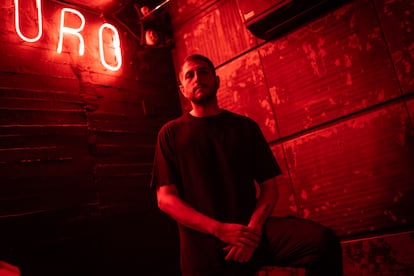
During the following years, he focused on turning his passion into a business. When he began his studies at the University of Medellín, he bought two speakers and a subwoofer and started renting them out for parties. “I was making a bit of money for my daily expenses. Just so I didn’t have to ask my mom for dough,” he recalls. Eventually, his clients began to ask him if he knew a DJ that played reggaeton. It struck him: “People want reggaeton? Well, I know reggaeton. I’ve heard it all my life, too.”
So, he became a reggaeton DJ. Without realizing it, urban music had become his life. In 2014, while still in college, he put together his first 100% reggaeton party; it was a watershed moment. “We sold a shitload of tickets in the cafeteria,” he remembers, laughing. It was around that time that he founded The Hacienda with two friends, to do “more and more and more and events.”
The most important reggaeton club in the world
Three years later and already established in the entertainment industry, he found himself one day in a basement in Provenza. He was enchanted by what he saw. “We didn’t want to open a nightclub because we assumed that they don’t last in this city,” he explains. But something was pulling him in. The space was perfect, he says. Plus, he felt like he could fill a void. “There was already a legendary salsa club, the Tíbiri. A rock club, the Blue. But there was no reggaeton club. There was no place that boasted, that bragged, that felt proud to play reggaeton,” he recalls.
One night, a few months after opening, reggaeton superstar J Balvin went there to sing. The legend of Perro Negro was taking shape. Cardona and his team agreed not to post “absolutely anything” about that visit on social media; it is a policy they still adhere to. “We always wanted growth to be organic,” he points out.
Psychologist Luisa Fernanda Espinal is currently studying a doctorate at EAFIT University on the social role of reggaeton in Medellín. She knows Perro Negro well. For her, beyond its organic growth, the club owes its success to the fact that it ended the existing gender prejudices. “Medellín has always been a classist city, with strong racist elements,” she says. Perro Negro broke those barriers: “It gave perreo status. It changed the logic of grinding in the city.”
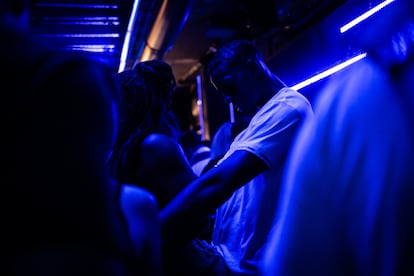
Espinal explains that, in addition to “the particularly intense reggaeton experience” that takes place there, the club is unique because it has gender violence prevention policies. “If you go into the women’s bathroom, you’ll find signs about preventing sexual exploitation. There are restrictions for unaccompanied men. They don’t let them go hunting.” All of this, she says, resulted in the middle and upper class of Medellín “clicking” with Perro Negro, and the club became very famous. “Its local prominence attracted artists, and the artists attracted tourists,” she adds. And with the arrival of the tourists, the club went viral.
Today, six years after its opening, Perro Negro’s fame reaches far beyond Medellín. The club has been mentioned in songs that have billions of streams on Spotify and YouTube. On any given night, it can be visited by a world star; according to the owner, celebrities like Bad Bunny, Karol G, Feid and Maluma have sung there this year. In addition, a little over a month ago they opened a second Perro Negro in Miami, and “it is full every night.” For Cardona, there is no debate: Perro Negro is “the most important reggaeton club in the world.”
A Paisa success story
The story of Perro Negro, explains ethnomusicologist Carolina Santamaría Delgado, from the University of Antioquia, is a classic example of Paisa (Antioquian) success. “Antioquians have that ‘if you need something, I’ll sell it to you’ kind of disposition,” she says. That is what, half a century ago, made Medellín the capital of the Colombian music industry. “Middle class people saw that music production was a big business, and that exploded,” she says.
But this is about more than just business; the people of Medellín have a special relationship with music. “Once a genre arrives, the people of Medellín appropriate it,” she continues. In the past, it happened with genres like tango, salsa and rock. Now, it is reggaeton’s turn.
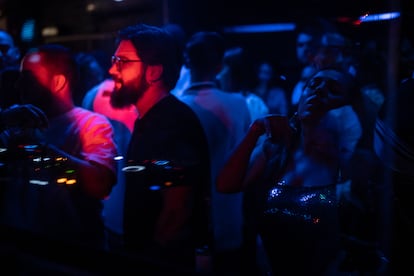
Cardona understands well that relationship between his city and music. After a couple of beers, he explains that Perro Negro owes its success to more than just the energy of the dance floor, the lights and the fact that they only play reggaeton; it is all about its connection with Medellín. “Medellín is a magical place because it has a physical limit. It cannot be bigger than it already is. It’s this valley and that’s it. There is nowhere else to go.”
Perhaps it is true that the capital of Antioquia cannot grow any more, but Perro Negro can. The day after this interview, Cardona took a plane to Spain; his goal for 2024, he says, is to open a third Perro Negro. This time, in Madrid.
Sign up for our weekly newsletter to get more English-language news coverage from EL PAÍS USA Edition
Tu suscripción se está usando en otro dispositivo
¿Quieres añadir otro usuario a tu suscripción?
Si continúas leyendo en este dispositivo, no se podrá leer en el otro.
FlechaTu suscripción se está usando en otro dispositivo y solo puedes acceder a EL PAÍS desde un dispositivo a la vez.
Si quieres compartir tu cuenta, cambia tu suscripción a la modalidad Premium, así podrás añadir otro usuario. Cada uno accederá con su propia cuenta de email, lo que os permitirá personalizar vuestra experiencia en EL PAÍS.
¿Tienes una suscripción de empresa? Accede aquí para contratar más cuentas.
En el caso de no saber quién está usando tu cuenta, te recomendamos cambiar tu contraseña aquí.
Si decides continuar compartiendo tu cuenta, este mensaje se mostrará en tu dispositivo y en el de la otra persona que está usando tu cuenta de forma indefinida, afectando a tu experiencia de lectura. Puedes consultar aquí los términos y condiciones de la suscripción digital.
More information
Archived In
Últimas noticias
Most viewed
- Oona Chaplin: ‘I told James Cameron that I was living in a treehouse and starting a permaculture project with a friend’
- Reinhard Genzel, Nobel laureate in physics: ‘One-minute videos will never give you the truth’
- Sinaloa Cartel war is taking its toll on Los Chapitos
- Why the price of coffee has skyrocketed: from Brazilian plantations to specialty coffee houses
- Silver prices are going crazy: This is what’s fueling the rally
